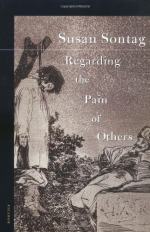
|
| Name: _________________________ | Period: ___________________ |
This test consists of 15 multiple choice questions and 5 short answer questions.
Multiple Choice Questions
1. Which of the following does Sontag suggest is an ethical act?
(a) Fighting.
(b) Loving.
(c) Mourning.
(d) Remembering.
2. In portraying horrors, Leonardo da Vinci encouraged artists to be:
(a) Cautious.
(b) Restrained.
(c) Pitiless.
(d) Sensitive.
3. Sontag claims that no one has a right to which of the following?
(a) Ignorance.
(b) Happiness.
(c) Bliss.
(d) Sympathy.
4. Which of the following phrases does Sontag use to refer to items which allow us to remember or think on death?
(a) Photography.
(b) Emblems of suffering.
(c) Memento mori.
(d) Memorabilia.
5. Which nation's army was represented in Wall's photograph?
(a) Iraq.
(b) Afghanistan.
(c) United States.
(d) Soviet Union.
6. Sontag claims that shock used for rhetorical purposes can become _________.
(a) Familiar.
(b) Damaging.
(c) New.
(d) Dangerous.
7. What is the primary message carried by images of atrocity?
(a) This is wrong.
(b) Never forget.
(c) This happened.
(d) We must change.
8. It was generally thought that public awareness was largely guided by which of the following?
(a) Book industry.
(b) Government propaganda.
(c) Educational programming.
(d) Media coverage.
9. Sarajevans were angered by a photography exhibit which featured photographs of their suffering alongside images of which other country's people?
(a) Somalia.
(b) Rhodesia.
(c) Bulgaria.
(d) Bosnia.
10. Sontag claims that witnessing atrocity through images is not much different than witnessing them in person. What does she say these activities had in common?
(a) Ability to be redirected, callousness and ease.
(b) Ease, distance and the ability to be redirected.
(c) Callousness, exploitation and distance.
(d) Callousness, distance and apathy.
11. In order to take pleasure in suffering, Sontag argues that one must necessarily have which of the following?
(a) A sense of moral or intellectual superiority.
(b) A sadistic streak characteristic of serial killers.
(c) Deep seated feelings of misanthropy.
(d) Distance from the source of suffering.
12. Sontag claims that sentimentality is often accompanied by which of the following?
(a) A tendency toward hypocrisy.
(b) A fervid religious commitment.
(c) A maudlin reaction to stories of war.
(d) A proclivity for brutality.
13. What sentiment concludes the book?
(a) The horror of war is unimaginable.
(b) War is inevitable.
(c) War photography should be banned.
(d) Photographs of atrocities must be endured.
14. In transforming an event or person into something that can be owned, photographs:
(a) Objectify.
(b) Commoditize.
(c) Degrade.
(d) Elevate.
15. Although images were more prevalent, which of the following was NOT also true?
(a) People's reactions to the images were greater.
(b) People's understanding of atrocity increased.
(c) Humanity became oversensitive to images of suffering.
(d) The human capacity to absorb the images of suffering increased.
Short Answer Questions
1. "Dead Troops Talk (A Vision After an Ambush of a Red Army Patrol near Moqor, Afghanistan, Winter 1986" was a photograph taken by which of the following types of photographer?
2. Discussing the common person's ability to feel sympathy, Sontag argues which of the following?
3. Sontag claims that there is no way to guarantee which of the following?
4. Which of the following thinkers argued that people take "no small" delight in witnessing the suffering of others?
5. Events enter the collective memory, not by a natural process of remembering but by:
|
This section contains 581 words (approx. 2 pages at 300 words per page) |

|




